|
|
 |
|
 |
| |
Publisher:
Chairman Ching-Fuh Lin Editors:
Professor I-Chun Cheng, Ms. Hsiao-wen Lin July 10,
2012 |
| |
|
 |
|
Congratulations to the following GIPO students under the supervision of GIPO professor Chee-Wee Liu and associate professor Jr-Hau He, on being awarded the Physical Society of Republic of China's 2011 Graduate Students' Excellent Theses Prize:
|
Prize |
Student's name |
Institute |
Title |
Adviser |
|
Excellent |
Hsin-Ping Wang |
Master student, GIPO |
Nanostructure Arrays Using Self-Assembly Templates for Broadband Omnidirectional
Light Harvesting of Solar Cells |
Jr-Hau He |
|
Good |
Tzu-Huan Cheng |
Ph.D. student, GIPO |
Ge-based Optoelectronics and the Study of Photovoltaic Devices |
Chee-Wee Liu |
|
Good |
Hung-Chih Chang |
Master student, GIPO |
Photon Management in Si-Based Solar Cells |
Jr-Hau He |
|
|
|
 |
|
 |
|
| |
|
 |
|
March
“Photonics Forum” Highlights
(Compiled by Li-Chi Yao) |
|
|
March 9th
(Friday), 2012, 3:30 pm |
|
Speaker: |
Tzong-Ching Ju (President, Taipei National University of the Arts) |
|
Topic: |
A Thousand Mountains and A Million Oceans Cannot Contain the Wings of Those Who Wish to Fly |
| |
President Tzong-Ching Ju visited GIPO and delivered a speech "A Thousand Mountains and A Million Oceans Cannot Contain the Wings of Those Who Wish to Fly." at auditorium 101, Barry Lam Hall, on March 9th, Friday. His speech was marvelous, well-considered in all respects. He interacted well with the GIPO teachers and students, who participated with great enthusiasm and benefited greatly from the experience.
|
| |
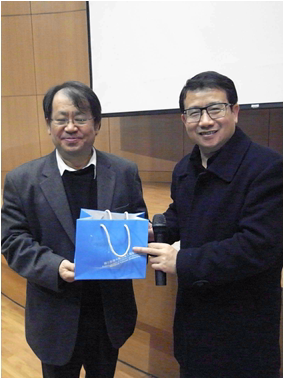 |
|
President Tzong-Ching Ju (left) and Chairman Ching-Fuh Lin (right), the host of the lecture |
|
|
|
March 23th
(Friday), 2012, 3:30 pm |
|
Speaker: |
Director Yi-Tseng Chuang
(Movie Director) |
|
Topic: |
Hand in Hand |
| |
Director Yi-Tseng Chuang visited GIPO on March 23rd (Friday). He delivered a speech on “Hand in Hand” at auditorium 101, Barry Lam Hall. Director Chuang’s speech was fascinating, and the GIPO students participated with enthusiasm and asked many questions. The audience benefited greatly from the event.
|
| |
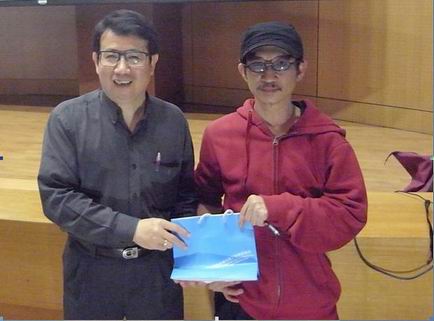 |
|
Director Yi-Tseng Chuang (right) with
Chairman Ching-Fuh Lin (left), the lecture host |
|
|
April
“Photonics Forum” Highlights
(Compiled by Li-Chi Yao) |
|
|
April 13th
(Friday), 2012, 3:30 pm |
|
Speaker: |
Ben Yang
(General
Manager, Pacific Venture Partners) |
|
Topic: |
An Overview of the LED Industry in Greater China Communities |
| |
General Manager Ben Yang visited GIPO and delivered a speech "An Overview of the LED Industry in Greater China Communities" at auditorium 101, Barry Lam Hall, on April 13th (Friday). His speech was splendid, well-considered in every respect. Mr. Yang interacted well with the GIPO professors and students. Everyone who had attended this event expressed great enthusiasm and gained a lot from it.
|
| |
|
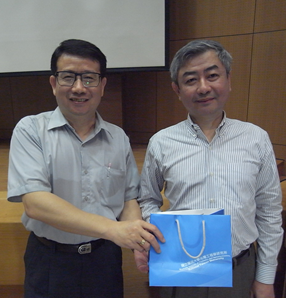 |
|
General Manager Ben Yang (right) and Chairman Ching-Fuh Lin (left), the host of this speech |
|
|
|
April 16th
(Monday), 2012, 10:10 am |
|
Speaker: |
Prof. Shun Lien Chuang
(Dept of ECE, University of Illinois) |
|
Topic: |
Metal-Cavity Nanolasers on Silicon: How small can they go? |
| |
Prof. Shun Lien Chuang visited GIPO and delivered a speech "Metal-Cavity Nanolasers on Silicon: How small can they go?" at auditorium 201, Barry Lam Hall, on April 16th (Monday). His speech was excellent. The GIPO students attended this event and asked questions with great enthusiasm. The audience benefited a lot from the event.
|
| |
|
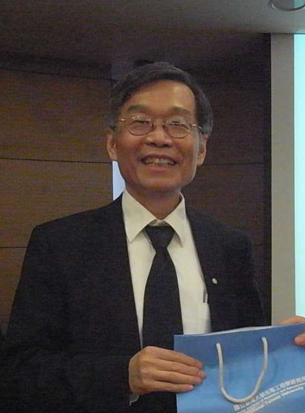 |
|
The speaker, Prof. Shun Lien Chuang |
|
|
|
April 27th
(Friday), 2012, 3:30 pm |
|
Speaker: |
Dr. Chang-Lin Tan
(General Manager, TSMC Solid State Lighting Co., Ltd.) |
|
Topic: |
Can a Major Semiconductor Player Accelerate the LED Cost Reduction Curve? |
| |
Dr. Chang-Lin Tan visited GIPO and delivered a speech "Can a Major Semiconductor Player Accelerate the LED Cost Reduction Curve?" at auditorium 101, Barry Lam Hall, on April 27th (Friday). Dr. Tan’s speech was fascinating, and he interacted well with the GIPO professors and students, who participated with enthusiasm and gained a lot from the event.
|
| |
|
|
 |
|
 |
|
| |
|
 |
|
Taiwan-Japan Nanophotonics and Plasmonic
Metamaterials Workshop
(Time:
January
11~12, 2012; Location:
Conference Room
201, Barry Lam Hall, NTU)
GIPO hosted the Taiwan-Japan Nanophotonics and Plasmonic Metamaterials Workshop on January 11~12, 2012 at Conference Room 201, Barry Lam Hall, NTU. This event was co-sponsored by the Photonics Advanced Research Center of Osaka University and GIPO. Eleven professors, two postdoctoral researchers and thirteen students from several Japanese universities, including Osaka University, were invited to Taiwan to attend this event. The twenty-six Japanese professors and students, arrived Taiwan on Jan. 10, attended the workshop on Jan. 11~12, and visited Din-Ping Tsai, Director General of the Instrument Technology Research Center of National Applied Research Laboratories, on Jan. 13.
During the two-day workshop, we had two plenary talks, delivered by Professor Satoshi Kawata of the Photonics Advanced Research Center of Osaka University and Dr. Yuh-Lin Wang of the Institute of Atomic and Molecular Sciences of Academia Sinica, respectively. We also had eighteen technical talks, delivered by the Japanese and Taiwanese speakers, including ten Japanese visiting professors; five GIPO professors; Dr. Juen-Kai Wang of the Center for Condensed Matter Sciences; Dr. Fong-Zhi Chen, the Deputy Director General of Instrument Technology Research Center of National Applied Research Laboratories; and Professor Da-Jen Yen of the Department of Materials Science and Engineering, National Tsing Hua University. In the afternoon of the first day, there was a poster session, which attracted fifty-two works from both Japanese and Taiwanese postdoctoral researchers and students. This workshop came to a successful end after having awarded the best posters during the closing ceremony on the second day. It boosted the exchange of ideas between and set a milestone for the Photonics Advanced Research Center of Osaka University and GIPO.
|
|
|
 |
|
 |
|
| |
|
 |
Room-temperature Low-threshold
Current-injection InGaAs
Quantum-dot Microdisk Lasers
with Single-mode Emission
Professor Ming-Hua
Mao's
Laboratory
Graduate Institute of Photonics and
Optoelectronics, National Taiwan
University
We fabricated current-injection InGaAs
quantum-dot microdisk lasers with
benzocyclobutene cladding successfully.
The benefits of this device
planarization process are the better
thermal conductivity and the less
fragility. With this structure, low
threshold current of 0.45 mA is achieved
at room temperature from a device of 6.5
μm in diameter with single-mode emission
from quantum-dot ground states. Through
a temperature dependent measurement, the
low loss level of our microdisk cavities
has been confirmed. These microdisk
lasers also show a characteristic
temperature significantly higher than
that of the edge-emitting lasers from
the same wafer. Therefore, single-mode
current-injection QD microdisk lasers
with very low threshold current are
demonstrated and they can serve as very
suitable light sources in a compact
integrated optical communication system.
This work has been published in Opt.
Express, Vol. 19, No. 15, pp. 14145,
(2011).
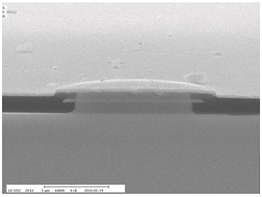 |
|
Fig. 1. The cross-section SEM
image of a current-injection
microdisk laser device. The
microdisk diameter is 10.5 μm. |
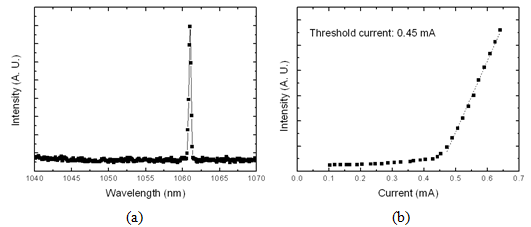 |
|
Fig. 2. (a) The mode spectrum of
a lasing 6.5-μm-diameter
microdisk. The WGM linewidth is
0.28 nm. (b) The L-I curve of
the 6.5-μm-diameter microdisk,
the threshold current is 0.45 mA. |
Using Hydrophilic Effect to
Fabricate Self-Assembled Microlens
Array by UV/ozone Modification
Professor Guo-Dung Su
Graduate Institute of Photonics and
Optoelectronics, National Taiwan
University
Micro-lens array (MLA) is an important
component and is used widely in many
applications, such as increasing the
light extraction efficiency, beam
shaping for illumination or light
gathering, wavefront sensor, and
information displays. There have been
many techniques to fabricate micro-lens
array, including thermal reflow, laser
ablation, direct laser writing, direct
e-beam writing, deep lithography with
protons, ink-jet printing, and
gray-scale mask methods. However, there
are still some drawbacks of these
techniques. Thermal reflow method
requires high temperature and the need
for an etch-transfer process. The
limited numerical aperture is also
concerned. In the laser ablation, the
problems are high facility cost and high
energy consumption. For the ink-jet
printing, the lens size and alignment
accuracy are limited. It is difficult to
fit the shape precisely and to
distinguish the gray levels in a sharp
edge by gray-scale mask method.
Therefore, a fast, cost effective,
stable, and focal length controllable
method is desirable to fabricate MLAs.
There is another approach to fabricate
MLAs using hydrophobic effect. This
approach offers an attractive
alternative because it allows accurate
and direct fabrication of polymer
microlenses without heating or post
etching of the substrate. The approach
is based on patterning hydrophobic
molecules on a substrate and
self-assembly of a liquid pre-polymer.
It was affected by different surface
energy on the hydrophilic domains. The
techniques to create patterns include
micro-contact printing (µCP) of
self-assembled mono layers (SAMs) and
adhesive lithography. It provided a
simpler method to fabricate MLAs using
the hydrophobic effect. However, it
still needs either an etch-transfer
process of µCP stamp or lithography for
an adhesive substrate. That increases
the cost and process complexity.
SU-8 photoresist (MicroChem, MA) has
high optical transmittance from visible
to near-infrared wavelength and high
refractive index (~1.63). Furthermore,
it has better chemical resistance and
mechanical strength than other common
polymers such as polycarbonate or PMMA.
As a result, SU-8 photoresist is ideal
for microlens array fabrication. In this
work done in Micro Optical Device Lab
(MODEL), a transparent and
self-assembled MLA fabricated by the
hydrophilic effect through ultra-violet
(UV)/ozone treatment is presented. A
base layer of SU-8 photoresist can be
surface modified to become more
hydrophilic using UV/ozone cleaner
(model UV-1, Samco). Contact angles on
the modified surface were ranged from
27˚ to 15˚ depending on the processing
time, UV power and ozone concentration.
The light source of UV/ozone cleaner is
110W with primary process wavelength of
254 and 182 nm. The oxygen flow rate is
0.5 L/min. The MLA was made of diluted
SU-8 photoresist, which has refractive
index mismatch from a glass substrate.
This method provides a fast, low cost,
no etch-transfer, no lithography
fabrication processes. The focal length
of MLA is controllable based on UV/ozone
treatment.
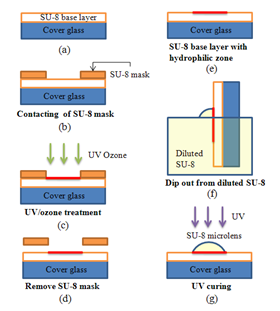 |
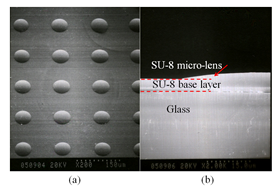 |
|
Figure 1. The fabrication
process of SU-8 photoresist MLA
using hydrophilic effect under
UV/ozone treatment. |
Figure 2. The SEM of (a)
microlenses of 100 μm diameter
under one minute UV/ozone
treatment time. (b) the cross
section profile of one minute
treated microlens. |
The Optical Theorem in FDTD Light
Scattering Simulation
Professor Snow H.
Tseng
Graduate Institute of Photonics and
Optoelectronics, National Taiwan
University
The total scattering cross-section (TSCS)
is a useful parameter in analyzing
light scattering properties. Here we
derive a pragmatic relationship of
the optical theorem to be employed
in a Finite-difference time-domain (FDTD)
simulation of light scattering
problems. Specifically, the accuracy
of the proposed TSCS calculation
method is analyzed and compared with
other methods. This research
solidifies the theoretical basis for
light scattering simulation studies.
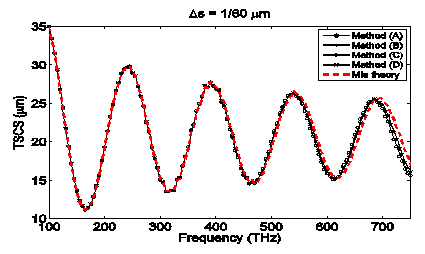 |
|
Fig. 1. Compare TSCS
calculated via various
methods in an FDTD
simulation with grid
resolution Ds =
1/60 mm.
Methods (A): Optical
theorem, (B): sum of
far-field RCS at all angles,
(C): near-field outgoing
Poynting vector flux, and
(D): definition of ECS. |
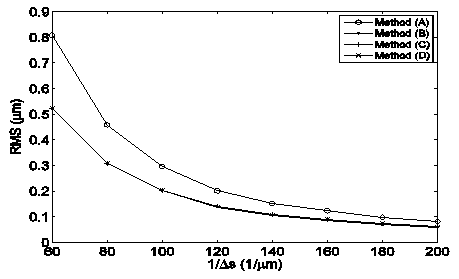 |
|
Fig. 2. Compare RMS error of
the TSCS calculation in an
FDTD simulation. |
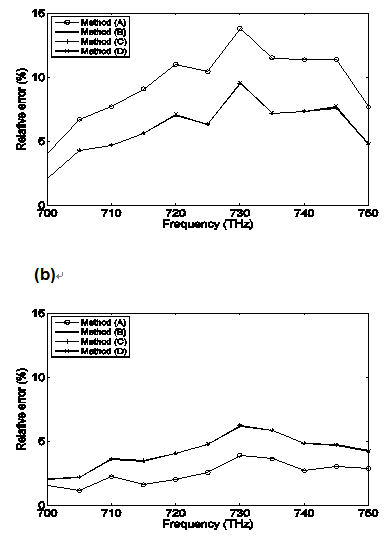 |
|
Fig. 3. Error of TSCS
calculation via various
methods compared with Mie
theory. The FDTD simulation
is performed with an FDTD
grid resolution of Ds =
1/60 mm.
(a) the error of TSCS
calculated via Optical
theorem is larger than
others; (b) after
compensating for the
numerical dispersion of a
frequency of 750 THz at 0
degree, the accuracy of
Optical theorem calculated
TSCS exceeds others. |
Emitting layer design of a
white organic light-emitting
device
Professor Jiun-Haw
Lee
Graduate Institute of Photonics
and Optoelectronics, National
Taiwan University
A white organic light-emitting
device (WOLED) based on a
phosphorescent blue and green
emitter combined with red
fluorescent one doped in a
single host is presented. In
such a device, efficient
phosphorescent sensitization
(PS) was achieved from the green
phosphorescent emitter to the
red fluorescent one, which was
directly observed from transient
electroluminescence. An undoped
region was inserted between the
green and blue dopant region to
stabilize the emission spectra.
In this configuration, the main
recombination zone was at the
blue-emitting region, and the
minor one was located at the
green one near the undoped
region. To avoid carrier
trapping, the red fluorescent
emitter with a reasonably high
concentration (0.5%) was doped
away from the minor
recombination zone. That WOLED
exhibited a longer operation
lifetime than the phosphorescent
blue/green device, because the
PS provided a radiative
efficient energy relaxation from
the green phosphorescent emitter
to the red fluorescent one
[published in Curr. Appl. Phys. 11,
S183, 2011].
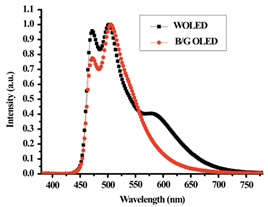 |
|
Fig.
1. Normalized EL spectra
of the WOLED and
blue/green OLED. |
 |
|
Fig.
2. Luminance decay
curves of OLEDs. |
Fabrication and characterization
of a micro tunable cat’s eye
retro-reflector
Professor Jui-che
Tsai
Graduate Institute of Photonics and
Optoelectronics, National Taiwan
University
We developed a micro tunable cat’s
eye retro-reflector. The tunability
is obtained through the use of a
smart film, a polymer dispersed
liquid crystal device (PDLC). The
cat’s eye device consists of three
subassemblies, a front-side focusing
unit, the smart film, and a
back-side reflecting unit. Device
characterization, considering
possible fabrication inaccuracy such
as misalignment, was performed (Fig.
1). The acceptance angle was
measured to be 9°. Switching of an
image pattern generated by a 2-D
array of such tunable cat’s eye
retro-reflectors was also
demonstrated (Fig. 2). The tunable
cat’s eye retro-reflectors can be
used in a free-space communication
system, or more specifically, an
optical identification system.
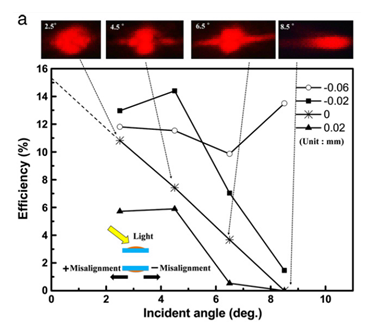 |
|
Figure 1 |
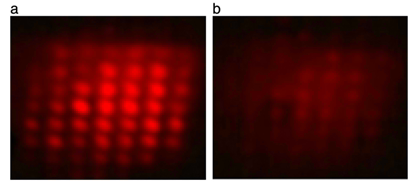 |
|
Figure 2 |
©
2011 Elsevier B.V.
K. H. Chao, C. D. Liao, B. J. Yang,
and J. C. Tsai, “Fabrication and
characterization of a micro tunable
cat’s eye retro-reflector,”Optics
Communications, Vol. 284, pp.
5221-5224, Oct. 2011.
Enhanced optical absorption
of dye-sensitized solar
cells
with microcavity-embedded
TiO2 photoanodes
Professor I-Chun Cheng
Graduate Institute of Photonics
and Optoelectronics, National
Taiwan University
We report the enhanced
performance of dye-sensitized
solar cells (DSSCs) with
microcavity-embedded nanoporous
TiO2 photoanodes.
For DSSCs with photoanodes
composed of a stack TiO2 sublayers
with microcavity concentrations
arranged from low to high on the
light illumination path, the
short-circuit current density
and the conversion efficiency
were improved. A pronounced
increase in optical absorption
and incident monochromatic
photon-to-current conversion
efficiency in the
long-wavelength region indicated
that the enhancement of cell
performance was due to the
multiple scattering of light by
the microcavities and the light
confinement by the stack of TiO2 sublayers
with a high-to-low effective
index of refraction. The
internal resistances and the
electron transport kinetics in
the TiO2 were
studied by electrochemical
impedance spectroscopy. The
Nyquist plots of the
electrochemical impedance
spectra of the DSSCs (Figure 1)
indicate that the presence of
microcavities does not influence
the electron lifetime in the TiO2 film
but does affect the charge
transport resistances at the TiO2/dye/electrolyte.
The short-circuit current
density and conversion
efficiency (Figure 2) were
improved by 26% and 20% for the
DSSC with photoanode in a
trilayer structure made using
TiO2 paste
mixed with 2 wt.%, 5 wt.% and 10
wt.% PS microspheres diluted in
DI water for the first, second
and third sublayers,
respectively.
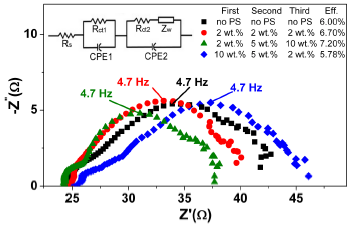 |
|
Figure
1 |
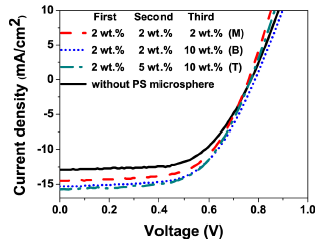 |
|
Figure
2 |
©2012 Optical Society of America
D.-W. Liu, I-C. Cheng, J. Z.
Chen, H.-W. Chen, K.-C. Ho, and
C.-C. Chiang, “Enhanced optical
absorption of dye-sensitized
solar cells with microcavity-embedded
TiO2 photoanodes,”
Optics Express, vol. 20, No. S2,
pp. A168-A176, Mar. 2012
Direct Side Pumping of
Double-Clad Fiber Laser by Laser
Diode Array Through the Use of
Sub-wavelength Grating Coupler
Professor Ding-Wei
Huang
Graduate Institute of Photonics and
Optoelectronics, National Taiwan
University
An electron-beam fabricated
sub-wavelength grating coupler for
direct side coupling of light
emission from a high-power laser
diode array was studied
theoretically and implemented
experimentally. A gold-embedded
silica-based design for grating
coupler was employed to minimize the
thermal expansion due to the
accumulated heat from light
absorption by metal part of the
grating coupler. In addition, with
the consideration of the backward
diffraction loss and the groove wall
non-verticality due to fabrication
distortion, the grating pitch and
groove width were optimized for the
highest coupling efficiency.
According to the experimental
results, the grating coupler is
capable of coupling light power up
to 21 W from a 976-nm
continuous-wave operated laser diode
array into the inner clad of a
400-μm-diameter double-clad fiber
with an overall coupling efficiency
of 50%. Furthermore, a laser diode
array side-pumped Ytterbium-doped
double-clad fiber laser by using the
grating coupler was demonstrated. By
fine tuning the slow-axis
collimation lens array, the laser
pumping scheme can easily be
switched between bi-directional
pumping and uni-directional pumping.
Compared with the uni-directionally
pumped fiber laser of the same gain
fiber length, the laser slope
efficiency of the bi-directionally
pumped fiber laser was increased by
18% due to a better gain
distribution over the fiber length.
Finally, the signal output power of
10 W with a slope efficiency of 61%
was achieved for the bi-directional
side-pumped fiber laser.
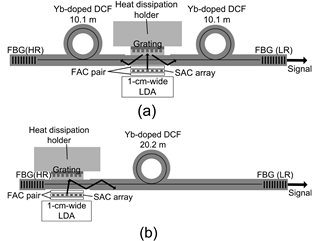 |
|
|
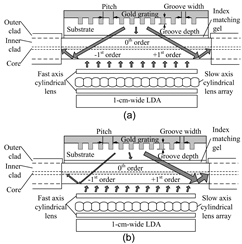 |
|
Fig. 1. Schematic
diagram of
side-pumped Yb-doped
fiber laser (a)
Bi-directionally
pumped Yb-doped
fiber and (b) Uni-directionally
pumped Yb-doped
fiber. FAC
represents the
fast-axis
collimation lens,
and SAC represents
the slow-axis
collimation lens. |
|
|
Fig. 2. Schematic
diagrams of the
gold-embedded silica
grating coupler with
(a) normal incident
pump light, and (b)
an angle of incident
pump light. |
|
|
|
|
|
|
Fig. 3 (a) The measured
laser signal output power
against coupled pump power
of bi-directional pumping
(square points) and uni-directional
pumping (triangular points)
schemes, respectively. (b)
Laser output spectrum for
bi-directional pumping at 1
W (black curve) and 10 W
(red curve) output power,
respectively. |
|
|
|
 |
|
 |
|
| |
|
|
 |
|
 |
|
|
|